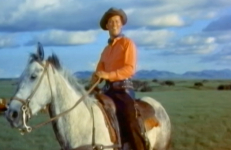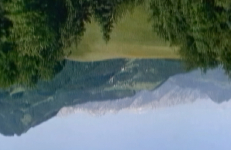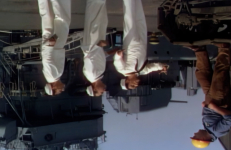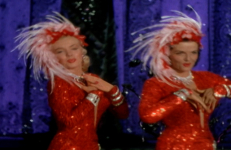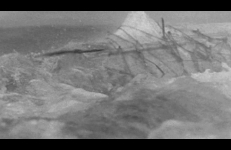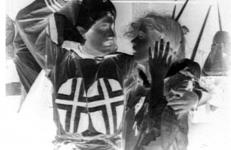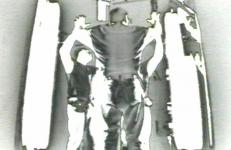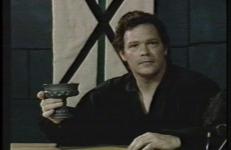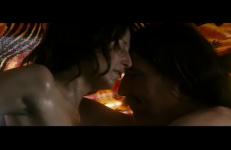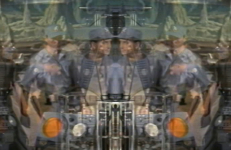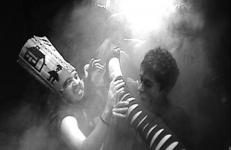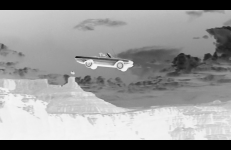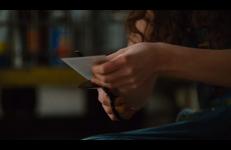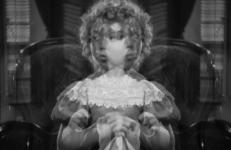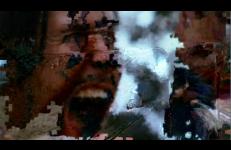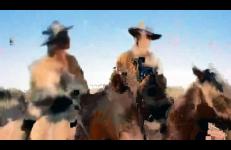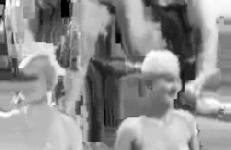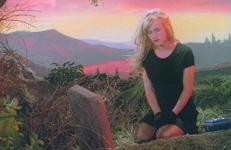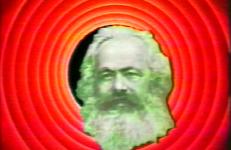This film is an appropriation from the 1955 movie Oklahoma. Each sync sound frame of the Overture and opening song "Oh, What a Beautiful Mornin’" is repeated 16 times and reorientated.
Hollywood
This film is an appropriation from the 1965 movie The Sound of Music. Each sync sound frame of the Prelude and opening song "The Hills are Alive" is repeated 16 times and reorientated.
This film is an appropriation from the 1949 movie On the Town. Each sync sound frame of the Overture, "I Feel Like I’m not of Bed Yet" and "New York New York" is repeated 32 times and reoriented.
This film is an appropriation from the 1953 movie Gentlemen Prefer Blonds. Each sync sound frame of the opening song "A Little Girl from Little Rock" is repeated 32 times and reorientated.
as the waves play along with an invisible spine (the workers die) is a stroboscopic work that pulsates black and white at approximately 14 Hz. Buried within that field of pulsation is a 90 second algorithmically condensed version of John Huston's 1956 film Moby Dick. Huston's minimal close-ups of the doomed sailors flicker as afterimage ghosts as approximately 4Hz in the visually unstable field of alternating black and white frames.
So long as the creature lives
it must carry forth its vertebrae
as the waves play along
Backwards Birth of a Nation is a re-editing of D.W. Griffith's 187-minute film, Birth of a Nation (1915), into a pulsating 13-minute black and white phantasm. By means of structural strategies of condensation, the frame by frame inversion of black and white, and playing the resulting work from end to beginning, an apparition is brought forth where images of racism float to the surface and are contextualised as a part of the flow of United States history.
A short atmospheric tour of a movie star’s mansion and a glimpse of the living things within the chambers: things that cook, feed the sharks, and gnaw on bones.
During my stint as an entry-level acquisitions scout at a now-defunct art house distribution company, I amassed a small collection of VHS tapes from a vast pool of unsolicited submissions. By the standards of the art house canon, these were very bad movies, but I adored them for the sincerity of their intention. Bits and pieces of these movies became source material for a number of the videos on this compilation (Teenagers, Hymn Of Reckoning, Fantasy Suite).
I loved and was haunted by Jon Krakauer’s book Into the Wild and found Sean Penn’s cinematic adaptation to be absurdly overwrought. My original plan for condensing it was to string together all of its grandiose slow-motion shots. I quickly realized that the result, like the movie itself, would be interminably long. A friend suggested that I leave out everything but the five-second shot that provoked me to make my video in the first place, the shot at which several audience members in the second-run theater (including me) laughed out loud.
Susan Mogul's fantasies of success have always a comic, congenial twist, as in Dear Dennis, a video letter to Dennis Hopper inspired by her discovery that they share the same dentist. The central irony of this witty piece is that, despite Hopper's popular persona as an innovative, sub-cultural filmmaker and performer, the actual distance between his so-called independent" films and Mogul's experimental, non-commercial videos prevents Susan from finding any common ground from which to address Hopper other than the subject of dental work.
Like a generation of viewers, I was profoundly affected by Deliverance. But I have always been troubled by the hegemonic structures of gender proposed by Boorman and Dickey. Hence, my version is played by women: myself, Peggy Ahwesh, Jackie Goss, Su Friedrich, and Meredith Root, all experimental filmmakers who work as academics. While faithful to our respective male characters, we also play ourselves.
Doubling Forbidden Planet is a feature length reedit of the 1956 science fiction film Forbidden Planet. This re-edit was produced in 2003 using a DIY apparatus of sequenced analog security system switchers, circuits and VHS players captured into a computer. The semi rhythmic and overlapping cuts produced by the switchers generated fragmented movement, dialogue, and soundtrack. Forbidden Planet’s soundtrack was made by Bebe and Louise Baron.
This high octane drama that I made with my students at the San Francisco Art Institute chronicles the moral decline of it's heroine, as the love of a man she obsesses over drives her over something else: a cliff into hell. It's a free fall all the way to the bottom destination, and there's a heck of a lot of nice looking, young people along for the ride.
Goodbye Thelma synthesizes footage from the 1991 film Thelma & Louise with footage of the author’s own making to create a mysterious, and at times disturbing, exploration of traveling alone. In contrast to the dramatic events of Thelma & Louise, this story is one of suspended fear, which inverts stunning vistas into unsettling and uncertain landscapes.
An experimental portrait of a lighting stand-in and body double for a famous Hollywood actress, and a glimpse at the behind-the-scenes of cinema production
Music by The Velvet Underground.
In this 1993 contribution to the On Art and Artists series, artist Art Jones describes his entry into the world of activist media, and the genesis of his belief in the potential for a democratized street-level media. Hailing from the Bronx, Jones recalls his personal dislocation during college, when he began studying film and video at SUNY Purchase. At that time, Jones experienced a cultural isolation, which he mobilized to fuel his practice. This willingness to confront issues of representation and absence, asserting the validity of his own subjecthood, would become a defining characteristic of his work.
a little girl dreams of a new pluralism meanwhile the old war continues V.1 2009, 67:00
Long Live the New Flesh uses found footage to transmogrify existing fragments from horror films into a new video. It deploys a digital technique with painterly quality in which the images literally consume one another and the horror in all its visual power is brought to a natural boiling point. Provost strips down the imagery of a mass medium, uses it to construct a new visual story behind the dissection and horror, and allows the viewer to cross every phase of the emotional spectrum.
Removing keyframes from a digital version of John Ford's The Searchers, Baron and Goodwin attack the film's temporal structuring to render a kinetic “painted desert” of the West. The dust kicked up by the movement in the film is pure pixel, unanchored from the photographic realism that used to constrain it.
Removing keyframes from a digital version of John Ford's The Searchers, Baron and Goodwin attack the film's temporal structuring to render a kinetic “painted desert” of the West. The dust kicked up by the movement in the film is pure pixel, unanchored from the photographic realism that used to constrain it.
In Lossless #5, a water-ballet crafted by the famed Busby Berkley is compressed into an organic mitosis, within which we detect the spirit of a "buggy" Brakhage ghosting about the integrated circuit.
In Lossless #5, a water-ballet crafted by the famed Busby Berkley is compressed into an organic mitosis, within which we detect the spirit of a "buggy" Brakhage ghosting about the integrated circuit.
Revolving around a movie mogul’s familial intrigues, Made In Hollywood tells the story of two artists selling out to make movies, and a simple country girl’s angelic rise to fame despite it all. As a copy of a copy, this tape critiques what it mimics, and, by revelling in the glitz and glamour of image-obsessed stars, exploits the love/hate relationship viewers have with their media icons: simultaneously viewing them as perfect models and ridiculous trumped-up figures existing only in the fantasy-land that is Hollywood.
Revolving around a movie mogul’s familial intrigues, Made In Hollywood tells the story of two artists selling out to make movies, and a simple country girl’s angelic rise to fame despite it all. As a copy of a copy, this tape critiques what it mimics, and, by revelling in the glitz and glamour of image-obsessed stars, exploits the love/hate relationship viewers have with their media icons: simultaneously viewing them as perfect models and ridiculous trumped-up figures existing only in the fantasy-land that is Hollywood.
Displaying a broad range of Golden Age Hollywood animation, Manifestoon is an homage to the latent subversiveness of cartoons. Though U.S. cartoons are usually thought of as conveyors of capitalist ideologies of consumerism and individualism, Drew observes: "Somehow as an avid childhood fan of cartoons, these ideas were secondary to a more important lesson—that of the 'trickster' nature of many characters as they mocked, outwitted and defeated their more powerful adversaries.




